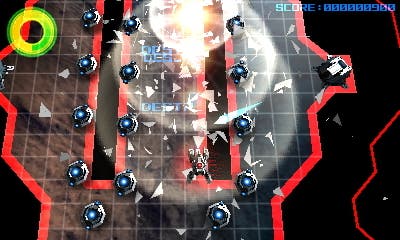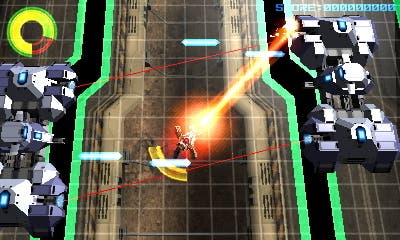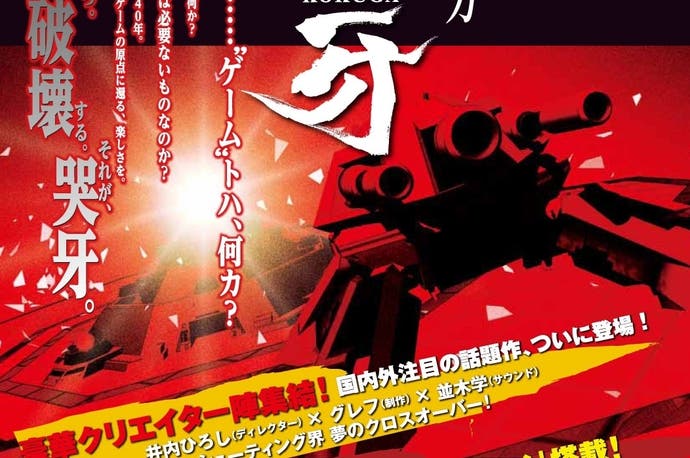Kokuga review
Huh, what? From the maker of Radiant Silvergun and Ikaruga? Gimme!
Kokuga landed on the eShop recently with alarmingly little fanfare. In ordinary circumstances, that would be understandable: publisher G.rev isn't likely to have any kind of marketing budget to give it a push, while many will be put off by its ostensibly expensive £13.49 price tag (although it received a full-price retail release last August in Japan, which helps explain it).
But these aren't ordinary circumstances, because Kokuga is the latest game from Hiroshi Iuchi, the director of Radiant Silvergun, Ikaruga and Gradius 5; in other words, the man responsible for three of the finest shooters ever made. In the event, it can't quite quite match up to those three. Though you might be surprised how close it gets.
The Kokuga itself is a typically elegant Iuchi creation, a futuristic tank that glides rather than rumbles, firing shells at a steady rhythm from a turret you rotate with the 3DS shoulder buttons. Your objective is as straightforward as it gets - destroy everything that moves and/or fires at you - although it requires a more measured approach than that suggests.

Your tank has a shield that depletes with every hit you take, and rapid fire and lasers can slice chunks off it in seconds, so you often need to play cautiously, drawing enemies out into the open, backing away from danger until they can't even be seen, the only evidence of their position the telltale blue rings that appear just as they're about to fire. Fighting at off-screen opponents is a bit of a game design no-no, but here it's a genuine strategy.
Even so, as you dispatch tanks, drones and static guns on the opening stage, you could be forgiven for thinking it's all a little slow, a little basic. And then you hit the first boss.
The object here is to destroy a series of turrets around its body while avoiding their fire. The music accelerates along with the pace as you dodge between the spray of projectiles. Once you've defeated those, more guns emerge, this time much smaller in size and thus harder to hit. Demolish those and a four-way rotating laser emerges, your job now to hit the small areas of the boss between the protective barriers at each side while ensuring you stay out of the way of the beams as they spin faster and faster and faster. If your weapon makes short work of the regular enemies, here it feels like a peashooter.
Happily, you can even the odds a little. You have a supply of 20 cards, of which five are displayed on the touch-screen at all times, each one triggered with a tap. The stock doesn't change, but the order is randomised, and intelligent use of these is necessary both to stay alive and to get a good score. Blue support cards refill your shield and give you a temporary force field, while red ones briefly give you more powerful ordnance: a laser, a dual cannon, a napalm bomb.
As a general rule, the more deadly the weapon the lower the multiplier you'll get for destroying anything with it. The radial laser's 4x bonus is the exception, although that requires you to get rather closer to your enemies than you might like: a classic balance between risk and reward.

Likewise, the gatekeepers. These large emplacements cordon off areas of the level, and most come with their own platoon of enemies. Defeat the gatekeepers and all members of the platoon will explode, but if you can blast all the grunts first, then your shield will get a much-needed top-up. The latter sounds like the better option, but in a tight spot - and there are plenty of those - you'll be glad of the alternative.
Once you've played a few stages, even the slower sections begin to make sense. The early stages of a level might seem unnecessarily sluggish, but any complacency is swiftly punished, and Iuchi starts to turn the screw with a series of tricks that empower even the feeblest opponents.
Several stages corral you into tight spaces with moving walls and giant mechanical constructions that slide and pivot, forcing you to time your advances very carefully. Just as you've mastered the art of the tactical retreat, one stage abandons the free-scrolling approach, automatically pushing you towards the exit through a gauntlet of enemies and a squall of projectiles. It's breathless stuff.
The bosses, too, are consistently inventive. There's a steel snake whose body segments are protected by short-range lasers. Two large mechs race on rails across either side of the screen, fencing you in with laser barriers, and only revealing their weak points when your turret is trained on their opposite number. One stage doesn't finish with a boss, instead placing four waddling mechs in small arenas at each corner. Elsewhere, three rotating towers demonstrate organic self-preservation instincts, turning their protective rears toward you when you fire.
Brilliantly, all of this is available from the start. The stage select screen is arranged into a triangle, and you can choose from any of the lettered missions, as a marvellously stern robotic voice urges you to. The only ones off-limits are the three Final stages at each corner, and they can be accessed when you complete any of the adjacent levels. This unusual structure is very briefly explained by the narrative: each of the regular stages is a training simulation for the real military operations in F1 to F3. Besides, you'll need all the practice you can get to beat them.
Kokuga's hard, then, but it's extremely fair, and the most devastating weapons make medals - if not high scores - achievable for most players. At least that's the case for Normal difficulty, although that's just the first of four settings. The final Boss Mode allows you to skip the build-up to face each guardian in its toughest form. It's here that Kokuga really comes into its own, as bullet hell becomes bullet heaven for those partial to the kind of challenge its creator's work is rightly renowned for.
Overall, a fanfare still seems unlikely for Kokuga, but the least Iuchi deserves is a warm round of applause.


.jpg?width=291&height=164&fit=crop&quality=80&format=jpg&auto=webp)






